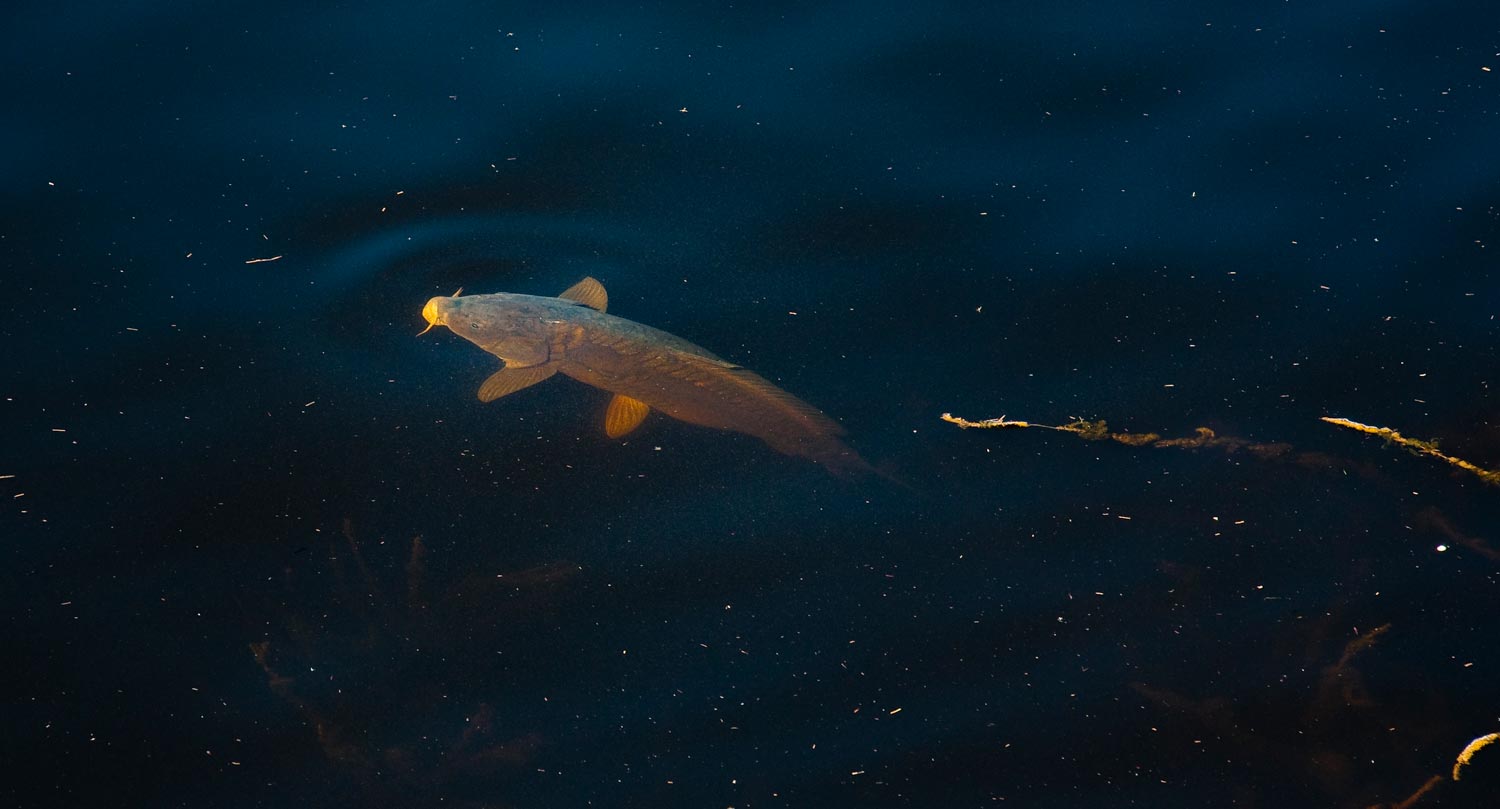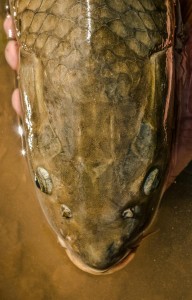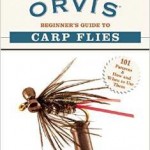by Dan Frasier
“If you think you know where to start without intimately knowing the water and fish you are about to chase, carp will whip your ass.”
John Gierach, in his book Death, Taxes and Leaky Waders, writes about expertizing. That is, acting the part of an expert. He explains, “Our answers are laced with complicated qualifications. They ramble, they’re never simple. Often they’re so obscure they end up being meaningless. But then, if you have to ask the question in the first place you probably won’t understand the answer, right?”
This, I must admit, is not a phenomenon to which I’m immune. It’s not that I hope to make anyone feel ignorant or inadequate, nor is it to make myself look like I know more than anyone else. It’s a product of how the information came to me. I didn’t learn how to catch carp by being presented a tidy thesis from which to work. I picked up information in bits and pieces over the years and apparently that is how my brain stored it.
When I later attempt to access that information in order to answer questions for other people, it tends to come out jumbled, full of caveats and obscure to the point of being useless. It’s frustrating to myself and to the person who just wanted to catch a damn carp or two.
Many extremely good carp anglers have written and presented eloquently on how to catch these fish. Often, top 10 lists of must-do’s are used. Sometimes, detailed descriptions of how to address particular situations are discussed. Oftentimes the expert is reduced to simply giving some generic thoughts and suggesting some experimentation. The problem is, I know too many guys are way too good at catching these fish.
That’s a problem because one expert is often saying things that are diametrically opposed to another. Two flyfishers, equally adept at catching carp on the fly, and two totally different set of rules. It has to be extremely confusing to the beginner.
The effect of all of this conflicting advice is that we have made carp out to be a practically uncatchable species, which feeds in a way so unique that you apparently have to be born an expert to even expect to hook up. There are so many rules, and points and counterpoints that the fish seem impossibly complicated. Of course, that’s crap.
The real problem is that each expert is an expert on their fish. I hear advice and descriptions that I know would fail miserably elsewhere. I’ve SEEN it fail miserably elsewhere. Hell, I’ve been the failer!
I’m nothing if not stubborn, and so, despite it’s difficulty, I will be doing a series of posts aimed at helping the carp novice enjoy success earlier and more often than I did. I’ll be discussing generalities that will apply on any water you fish. There won’t be specific advice, or fly suggestions. That’s a fool’s errand. The fact is, if you think you know where to start without intimately knowing the water and fish you are about to chase, carp will whip your ass. So lets discuss the questions that only you can answer that will produce a successful carp outing.
What are they eating?
I discussed, recently, in an edition of Angling Trade, the quandary of carp fly selection. If you’ve read it, allow me to repeat myself. If not, it’s so important you should read it twice.
Carp have been so successfully introduced to non-native waters because they are both generalists and specialists in their feeding habits. That is to say, carp can eat a huge variety of organisms, allowing them to thrive in almost any water, regardless of what forage is available. In that way they are generalists. One the other hand, carp will identify and key in on only the food source that is most efficient on any given body of water.
Where that is baitfish, they eat almost exclusively baitfish. Where that is nymphs they eat almost exclusively nymphs and where that is cottonwood seeds they will eat those. So carp manage to be aggressive generalist feeders as a species, and selective specialist eaters as a local population.
This fact makes your first most pressing question one that only you can answer. When asked, “What fly should I use for carp?” The answer must be, it depends on the water you’re about to fish. Anyone that answers this question with a fly is answering for what works on their water, which may or may not translate to yours.
I realize that sounds dramatic, but just look at the selection of flies in my book. Everything from size 16 Parachute Adams to 4-inch long articulated streamers are being used to catch carp. Where the streamers work, the dries don’t and vice versa. You have to think of each carp population as a riddle and start working out answers before anything like specific fly selection can be discussed.
There are a number of tells that can help identify what local carp are eating. Start with fish behavior. If the fish are rooting in the mud and moving slowly, they are probably digging out things that live in the mud. Things like worms and nymphs. If they are feeding on the surface look for the bugs or plant life that is abundant on the surface. If they are hunting along and occasionally grabbing something that is fleeing, they are chasing larger prey, like baby crayfish. The point is, start with observing the behavior of the feeding carp and then try to relate that to something that is living in the water. That will take you further than using something you saw on Facebook.
The second tell is to believe, on faith, that the carp are eating what is easiest. You may not actually observe the behavior, but if you dig in the mud a little and flip over some rocks, or just think about the small prey that is probably abundant on your water, you will be on the right track.
Silty-bottomed ponds with abundant plant life will sustain an immense amount of underwater insects. Carp in that type of water will probably be keyed into them. Match the size of those insects and present your fly appropriately and you are off and running.
On the other hand, sterile water bodies with rocky bottoms devoid of plants will be more likely to have baitfish and crayfish in the numbers required to sustain a carp population. The carp will probably be more aggressive there. The point is, if you can’t see or discern the carp behavior, do just what you do with trout. Let the habitat and visible animal life tell you where to start.
The last tell, which I use frequently, is the knowledge of local anglers. Anytime I’m traveling to a new place to fish I simply ask a local and do what I’m told. I may have caught more carp in my life than that person, and I may know people elsewhere that have caught tons of big fish on specific flies, but nothing beats the knowledge of a successful local angler.
There is always room for improvement, and I may find, after observing some fish or the water, that I can be even more successful fishing a different style of fly, but I’d rather start with some local knowledge and work my way out, than try to bring in some outside information and work my way in. In other words, you’re better off asking your local shop owner what they get carp on in their water than to ask me.
Try these tactics on the carp water you’re fishing and see if you can’t figure out what they’re eating.
Dan’s new Book, “The Orvis Beginner’s Guide To Carp Flies” is awesome!
Get Your Copy HERE!
Dan Frasier Gink & Gasoline www.ginkandgasoline.com hookups@ginkandgasoline.com Sign Up For Our Weekly Newsletter!




Great article. I have yet to catch a carp. I tried here and there last year, but had no success. It’s one of my target species this summer so I’ll definitely be looking forward to you talking about them more in the future.
Super well put Dan! Knowing your water IS the most important item for success I can think of. Spending time on this water so as to become familiar with the carp behavior seasonally is the second step. Putting together a simple as possible fly selection follows, flies you much faith in. But you said all that already.
Gregg
Glad you enjoyed it Gabriel. Good luck getting after them this year. They are tough fish, but once you stick a couple you’ll be off and running.
“The last tell, which I use frequently, is the knowledge of local anglers.”
^^^^^This!^^^^^
Started carpin in the LA River just two weekends ago, and would have caught nothing if not for my local fishing buddies. Nymph-drifting an “Over Sleasy” pattern is the bomb here.
South Africans are avid carp fisherman and we’ve developed some interesting and very effective fly patterns for carp; check these two articles for more tips on fly fishing for carp:
http://feathersandfluoro.com/?p=9591
http://feathersandfluoro.com/?p=9757
Hope you find the tips helpful!
I am a blogger and a carp fly fisherman living in Spain and I just wanted to say I thought your article was excellent. Pontificating to others on the basis of what has been successful for you is an easy trap to fall into and you are quite correct in thinking that there is no universal solution that can be applied anywhere – not with this fish! I find that carp on my local river feed and behave quite differently from in many of the large reservoirs here. Anyway, thanks for the article and well done!